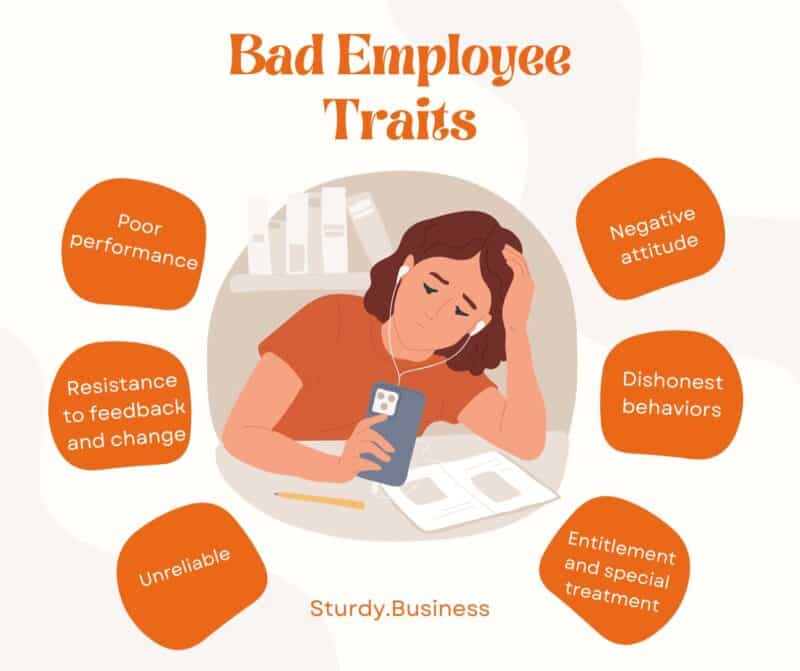If you’ve worked in any organization as a manager or employee, you’ve likely encountered problem employees.
It’s no secret that both good and bad employees are part of every workplace. However, even a few bad employees can ruin the morale and productivity of a team.
While some difficult employees need guidance and can improve over time, others resist change and negatively impact the organization.
Research shows that underperforming employees cost companies thousands of dollars daily and waste valuable work hours.
As a leader, it’s crucial to identify, manage, and, if necessary, remove these employees to maintain a healthy work environment.
This article will guide you through recognizing the common traits of bad employees and provide practical strategies to address them effectively, helping you foster a positive, productive workplace where your best employees can thrive.
On this page
Types of bad employees:
To understand how these traits manifest, let’s identify specific types of bad employees:
- The underperformer: These bad employees consistently fail to meet targets or expectations, contributing minimally to the team’s overall success.
- The disruptor: These poor employees often create conflict, spread rumors, or engage in gossip, negatively affecting team morale.
- The loner: This is another type of bad employee who refuses to collaborate with others, prefers to work in isolation, and is resistant to teamwork.
- The resistant: Resistant employees also fall into the category of bad employees. They resist change, refuse to adopt new processes or technologies, and often hinder innovation.
You must take time to identify these types of bad employees as soon as possible. Identifying these types early can help you tailor your management strategies accordingly.
Common bad employee traits:

Bad employee behaviors often fall into the following categories. Identifying these behaviors early on can help you take appropriate measures:
Poor performance:
A consistent lack of performance is a key indicator of a problem employee. They often fail to meet deadlines, deliver subpar work, or are frequently absent.
According to CCL research, 25% of problem employees are poor performers.
Actionable tip: When hiring, thoroughly check past performance records and ask previous employers about the candidate’s work habits and results.
Resistance to feedback and change:
It’s a very common practice that problematic employees often resist feedback, ignoring suggestions for improvement. They refuse to adapt to new methods or practices, hindering growth and innovation.
Actionable tip: Regular performance reviews and open communication can help address this resistance. However, if no progress is made, consider formal warnings or probation.
Negative attitude:
Another common trait of bad employees is a negative attitude, which should be managed as a top priority. A negative attitude can quickly spread throughout the team, reducing morale and productivity. These employees often blame others for their shortcomings and create unnecessary conflict.
Actionable Tip: Address negative behaviors early through coaching and counseling sessions. Encourage a positive work culture that discourages negativity.
Unreliable and dishonest behaviors:
Bad employees are often dishonest and unreliable. They fail to follow through on commitments, miss deadlines, and often have numerous excuses for poor performance.
Actionable tip: Establish clear expectations and hold employees accountable for their actions. Use reliable task-tracking systems to identify patterns of unreliability.
Entitlement and special treatment:
Some employees believe they deserve special treatment without putting in the effort or delivering results, which leads to tension and resentment among the team. This sense of entitlement is another clear sign of a bad employee.
Actionable tip: Treat all employees fairly, with transparent criteria for promotions and rewards. This reduces feelings of favoritism or unfairness.
Causes of bad employee traits:
As mentioned earlier, some bad employees may simply need better communication and treatment. It’s important to listen to them first to identify the causes of the negative traits they have developed over time. Often, there may be relatively simple issues in the work environment that you can address to help turn them into loyal employees.
Understanding the root causes of these behaviors is crucial for effectively addressing them. Here are some root causes that can turn even good employees into bad ones.
- Poor management practices: Lack of communication, unclear expectations, and inconsistent policies can contribute to negative employee behaviors.
- Personal issues or stress: Employees dealing with personal problems or stress may exhibit negative behaviors at work.
- Lack of engagement: When employees feel disengaged or undervalued, they are more likely to develop bad habits.
Impact of bad employee traits on the workplace:
Bad employee behaviors can have several negative consequences. Here are some of the very common and dangerous ones:
- Reduced team morale: When bad employees dominate the workplace, good employees often feel demotivated or undervalued, reducing engagement and productivity.
- Increased turnover: Toxic behaviors can cause valuable employees to leave, increasing turnover costs and disrupting team dynamics.
- Financial costs: Research shows that underperforming employees can cost organizations thousands of dollars in lost productivity and wasted resources.
Signs and indicators of bad employee traits:
To identify bad employees early, watch for these warning signs:
- Frequent absenteeism or tardiness.
- Poor communication or lack of response to feedback.
- Resistance to new policies or changes.
- Consistent negative comments or gossip.
How to manage and mitigate bad employee traits?
Here are practical steps to address these behaviors:
- Set clear expectations: Clearly communicate your expectations regarding performance, behavior, and teamwork.
- Provide regular feedback: Regularly review performance and provide constructive feedback to encourage improvement.
- Offer coaching and development: Help employees improve through training, mentorship, and professional development opportunities.
- Take decisive action: If behaviors do not improve despite coaching, consider formal disciplinary measures or termination to protect the organization’s culture.
Conclusion:
Bad employees can cost your organization time, money, and valuable team members. By understanding the common traits, their impact, and how to manage them, you can create a more positive and productive workplace. Be proactive in identifying and addressing bad employee behaviors to maintain a healthy organizational culture.